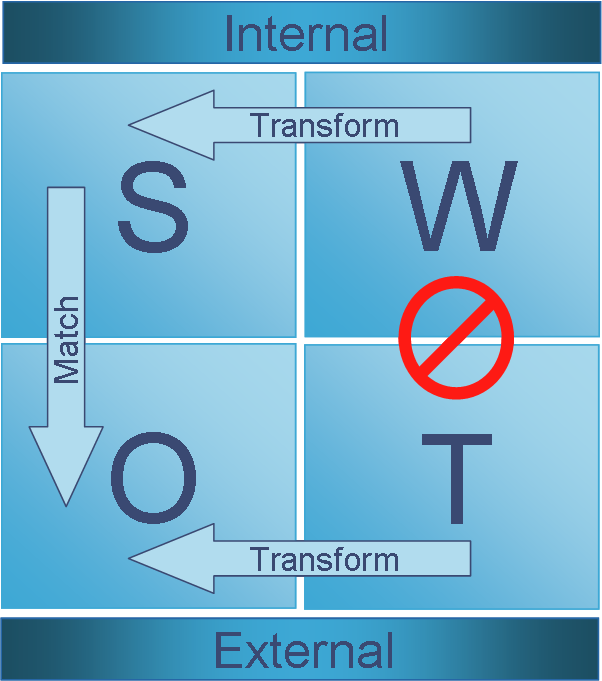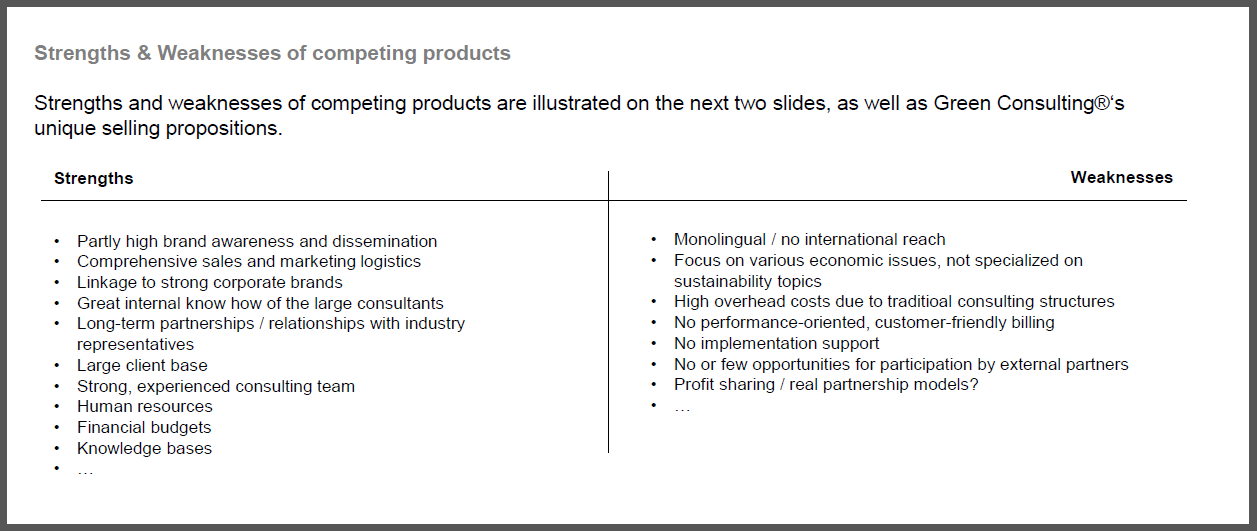SWOT analysis Wikipedia the free encyclopedia
Post on: 16 Март, 2015 No Comment

A SWOT analysis, with its four elements in a 2×2 matrix.
A SWOT analysis (alternatively SWOT matrix ) is a structured planning method used to evaluate the strengths, weaknesses, opportunities and threats involved in a project or in a business venture. A SWOT analysis can be carried out for a product, place, industry or person. It involves specifying the objective of the business venture or project and identifying the internal and external factors that are favorable and unfavorable to achieve that objective. Some authors credit SWOT to Albert Humphrey. who led a convention at the Stanford Research Institute (now SRI International ) in the 1960s and 1970s using data from Fortune 500 companies. [ 1 ] [ 2 ] However, Humphrey himself does not claim the creation of SWOT, and the origins remain obscure. The degree to which the internal environment of the firm matches with the external environment is expressed by the concept of strategic fit .
- Strengths: characteristics of the business or project that give it an advantage over others.
- Weaknesses: characteristics that place the business or project at a disadvantage relative to others.
- Opportunities: elements that the project could exploit to its advantage.
- Threats: elements in the environment that could cause trouble for the business or project.
Identification of SWOTs is important because they can inform later steps in planning to achieve the objective.
First, the decision makers should consider whether the objective is attainable, given the SWOTs. If the objective is not attainable a different objective must be selected and the process repeated.
Users of SWOT analysis need to ask and answer questions that generate meaningful information for each category (strengths, weaknesses, opportunities, and threats) to make the analysis useful and find their competitive advantage.
Contents
§ Matching and converting [ edit ]
One way of utilizing SWOT is matching and converting. Matching is used to find competitive advantage by matching the strengths to opportunities. Converting is to apply conversion strategies to convert weaknesses or threats into strengths or opportunities. An example of conversion strategy is to find new markets. If the threats or weaknesses cannot be converted, a company should try to minimize or avoid them. [ 3 ]
§ Internal and external factors [ edit ]
So it is said that if you know your enemies and know yourself, you can win a hundred battles without a single loss. If you only know yourself, but not your opponent, you may win or may lose. If you know neither yourself nor your enemy, you will always endanger yourself.
SWOT analysis aims to identify the key internal and external factors seen as important to achieving an objective. SWOT analysis groups key pieces of information into two main categories:
- internal factors – the strengths and weaknesses internal to the organization
- external factors – the opportunities and threats presented by the environment external to the organization
Analysis may view the internal factors as strengths or as weaknesses depending upon their effect on the organization’s objectives. What may represent strengths with respect to one objective may be weaknesses (distractions, competition) for another objective. The factors may include all of the 4Ps ; as well as personnel. finance. manufacturing capabilities, and so on.
The external factors may include macroeconomic matters, technological change. legislation. and sociocultural changes, as well as changes in the marketplace or in competitive position. The results are often presented in the form of a matrix .
SWOT analysis is just one method of categorization and has its own weaknesses. For example, it may tend to persuade its users to compile lists rather than to think about actual important factors in achieving objectives. It also presents the resulting lists uncritically and without clear prioritization so that, for example, weak opportunities may appear to balance strong threats.
It is prudent not to eliminate any candidate SWOT entry too quickly. The importance of individual SWOTs will be revealed by the value of the strategies they generate. A SWOT item that produces valuable strategies is important. A SWOT item that generates no strategies is not important.
§ Use [ edit ]
The usefulness of SWOT analysis is not limited to profit-seeking organizations. SWOT analysis may be used in any decision-making situation when a desired end-state (objective) is defined. Examples include: non-profit organizations. governmental units, and individuals. SWOT analysis may also be used in pre-crisis planning and preventive crisis management. SWOT analysis may also be used in creating a recommendation during a viability study /survey.
§ Strategy building [ edit ]
SWOT analysis can be used effectively to build organization or personal strategy. Steps necessary to execute strategy-oriented analysis involve: identification of internal and external factors (using popular 2×2 matrix), selection and evaluation of the most important factors and identification of relations existing between internal and external features. [ citation needed ]
For instance: strong relations between strengths and opportunities can suggest good condition of the company and allow using aggressive strategy. On the other hand strong interaction between weaknesses and threats could be analyzed as potential warning and advise for using defensive strategy. [ citation needed ]

§ Criticism [ edit ]
Some findings from Menon et al. (1999) [ 4 ] and Hill and Westbrook (1997) [ 5 ] have shown that SWOT may harm performance. Other complementary analyses have been proposed, such as the Growth-share matrix and Porter five forces analysis .
Heinz Weihrich said that some users found it difficult to translate the results of the SWOT analysis into meaningful actions that could be adopted within the wider corporate strategy. He introduced the TOWS Matrix, a conceptual framework that helps in finding the most efficient actions. [ 6 ]
§ SWOT — landscape analysis [ edit ]
The SWOT-landscape systematically deploys the relationships between overall objective and underlying SWOT-factors and provides an interactive, query-able 3D landscape.
The SWOT-landscape grabs different managerial situations by visualizing and foreseeing the dynamic performance of comparable objects according to findings by Brendan Kitts, Leif Edvinsson and Tord Beding (2000). [ 7 ]
Changes in relative performance are continually identified. Projects (or other units of measurements) that could be potential risk or opportunity objects are highlighted.
SWOT-landscape also indicates which underlying strength/weakness factors that have had or likely will have highest influence in the context of value in use (for ex. capital value fluctuations).
§ Corporate planning [ edit ]
As part of the development of strategies and plans to enable the organization to achieve its objectives, that organization will use a systematic/rigorous process known as corporate planning. SWOT alongside PEST /PESTLE can be used as a basis for the analysis of business and environmental factors. [ 8 ]
- Set objectives – defining what the organization is going to do
- Environmental scanning
- Internal appraisals of the organization’s SWOT, this needs to include an assessment of the present situation as well as a portfolio of products/services and an analysis of the product/service life cycle
§ Marketing [ edit ]
In many competitor analyses, marketers build detailed profiles of each competitor in the market, focusing especially on their relative competitive strengths and weaknesses using SWOT analysis. Marketing managers will examine each competitor’s cost structure, sources of profits, resources and competencies, competitive positioning and product differentiation, degree of vertical integration. historical responses to industry developments, and other factors.
Marketing management often finds it necessary to invest in research to collect the data required to perform accurate marketing analysis. Accordingly, management often conducts market research (alternately marketing research) to obtain this information. Marketers employ a variety of techniques to conduct market research, but some of the more common include:
- Qualitative marketing research, such as focus groups
- Quantitative marketing research, such as statistical surveys
- Experimental techniques such as test markets
- Observational techniques such as ethnographic (on-site) observation
- Marketing managers may also design and oversee various environmental scanning and competitive intelligence processes to help identify trends and inform the company’s marketing analysis.
Below is an example SWOT analysis of a market position of a small management consultancy with specialism in HRM. [ 9 ]














